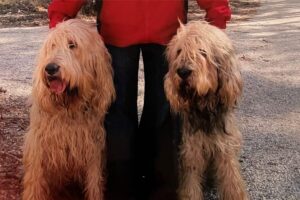
Correct Feet Form the Base for the Well-Moving Otterhound
Delve into the world of Otterhound feet and movement. Uncover their vital role in agility, endurance, and versatile terrain performance.

Home » Dog Breeds » Otterhound Dog Breed
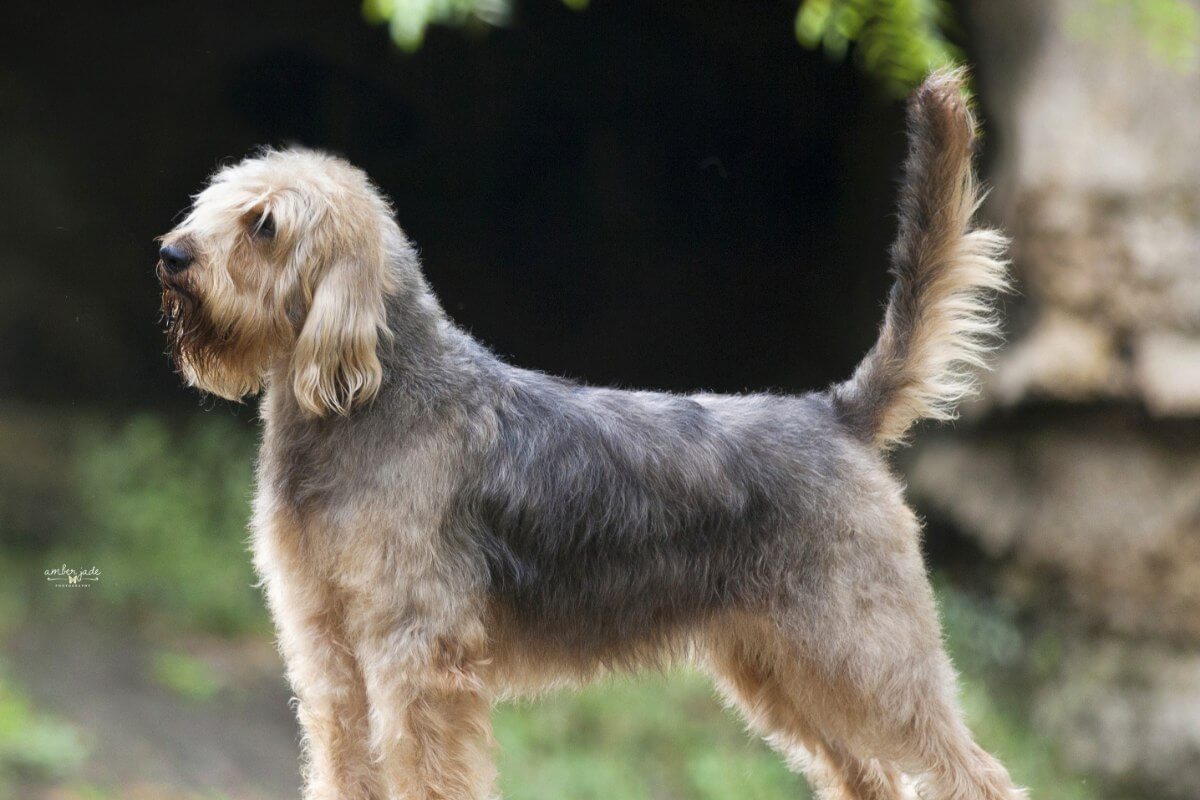
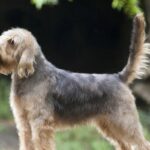
The Otterhound is a rare and imposing breed of dog, recognized for its robust build and distinctively shaggy coat. Since the Middle Ages, the breed has been utilized primarily for hunting the river otter, a seriously formidable foe. Unusual for a hound, this breed is characterized by its affinity for water as well as for its keen sense of smell. This unique combination of qualities sets this courageous canine apart from other scenthound breeds.
Hound
24 – 27 Inches
80 – 115 Pounds
10 – 13 Years
| Country of Origin | England |
|---|---|
| Bred For | Hunting, Companionship |
| Known For | Friendliness, Affection, Shaggy Appearance |
| Popularity | Low |
| Temperament | Amiable, Boisterous, Even-Tempered |
| Activities | Hunting, Running, Swimming, Search and Rescue, Conformation Shows, Dog Sports |
The origins of the Otterhound are shrouded in mystery, with the breed tracing its history back centuries in the British Isles. It is widely believed that the breed evolved from ancient hounds used by the Celts that were brought to England before the Roman invasion. Their primary purpose was hunting otters, which were a significant threat to fish populations in rivers and lakes. As otters became scarce, their primary function slowly transitioned to other activities, but their name remained a testament to their original task.
Throughout the Middle Ages and during the Renaissance, the breed’s prowess in hunting otters made these dogs popular among English nobles. The breed’s acute sense of smell, combined with its water-resistant coat and webbed feet, made these hounds particularly adept at the task. Their hunting prowess earned them a mention in several Olde English manuscripts, indicating their prominence in hunting circles at the time.
By the 20th century, however, otter hunting in the UK had declined significantly, When the hunting of otters was banned in 1978 due to conservation concerns, the breed’s numbers plummeted as a result. With its primary functional purpose gone, the breed faced the threat of extinction. Thanks to the efforts of dedicated breed enthusiasts, the Otterhound has been preserved and is being promoted as a lovable companion.
The American Kennel Club (AKC) recognized the Otterhound in 1909. In Europe, the breed is also recognized by the Fédération Cynologique Internationale (FCI) and The Royal Kennel Club (UK).
Today, while still relatively rare, the Otterhound enjoys life as a loyal family member for a discerning few, often participating in dog sports and other canine activities.
Adult male Otterhounds typically stand at 27 inches tall at the shoulder, while mature females are generally smaller, usually measuring around 24 inches tall.
In terms of weight, males generally weigh approximately 115 pounds, with females typically weighing about 80 pounds.
The Otterhound boasts a harmonious combination of power and agility. The breed’s body is slightly longer than it is tall, giving this hound a somewhat rectangular silhouette. This proportion allows for a flexible and enduring stride, essential for the breed’s historic role as a pack hound. The breed’s substance is undeniably solid, with strong bone and a well-muscled physique. The robust construction, combined with balanced proportions, allows the Otterhound to capably work over challenging terrain and in wet environments with ease and stamina.
Texture: The breed’s coat is notably rough and dense. It is a double coat that’s waterproof, which aided the Otterhound in its historic water-related tasks, offering protection in cold water and harsh terrain. A correct coat is an essential feature of the breed.
| Standard Color | |
|---|---|
| Black | ee |
| Black & Tan | ee |
| Blue & Cream | ee |
| Gray | ee |
| Liver & Tan | ee |
| Tan | ee |
| Wheaten | ee |
| Blue | ee |
| Lemon | ee |
| White | ee |
| White Black & Tan | ee |
| Standard Marking | |
|---|---|
| Badger Markings | ee |
| Black Markings | ee |
| Black & Tan Markings | ee |
| Grizzle Markings | ee |
| Liver Markings | ee |
| White Markings | ee |
| Lemon Markings | ee |
| Silver Markings | ee |
| Tan Markings | ee |
| White & Tan Markings | ee |
A Note About Color: The double coat of the Otterhound has an unkempt appearance. It consists of a harsh outer coat and a water-resistant undercoat. The outer coat can vary in length and may be softer in texture on the legs. Most puppies are born dark in color, with coats that typically lighten as they age. Any color or color combination is acceptable. The color of the nose and eye rims may be black, slate or liver, depending on the coat’s coloration. The nose should be dark and fully pigmented.
The tail of an Otterhound is a noteworthy aspect of its anatomy, complementing the breed’s robust build and powerful stride.
The tail is set high and extends in a gentle, saber-like curve, reaching to the hock when the dog is at rest. In motion, the Otterhound carries its tail elevated but not overly so; it should not curl over the back. This carriage showcases the breed’s confidence and keen sense of purpose.
The tail is well-covered with hair, mirroring the rough texture of the breed’s coat. This not only adds to its aesthetic appeal but also serves a functional purpose, aiding in the dog’s balance while maneuvering through water and over uneven terrain.
The Otterhound’s tail is not docked. The natural length and carriage of the tail are considered essential characteristics, accentuating the breed’s silhouette and graceful way of going.
Owning an Otterhound is a unique experience filled with joy, challenges, and countless learning opportunities. As with any breed, understanding the specific needs and characteristics of the Otterhound is crucial to ensure a harmonious coexistence.
Otterhounds, like all breeds, come with their own set of health concerns to be aware of. Generally, they are hardy dogs, but due diligence on the part of the owner can ensure a long and healthy life for their canine companion.
Lifespan: The average life expectancy of an Otterhound is around 10 to 13 years. Proper care, regular veterinary check-ups, and a balanced diet can contribute to reaching or even surpassing this age range.
Otterhounds, like all breeds and mixed breeds, are susceptible to certain health conditions. Being aware of these potential risks can equip an owner to detect early signs and seek timely medical intervention.
In addition to being aware of these common health issues, it’s important for Otterhound owners to maintain regular vet check-ups. Routine examinations can help in early detection of potential health concerns, allowing for timely intervention and treatment.
The Otterhound possesses a personality that is as distinctive as the dog itself. Breed enthusiasts often describe this scenthound as friendly, independent, and even a bit clownish. And while the breed’s amiable nature makes this hound a wonderful companion, its strong hunting instincts and independent streak can sometimes be a challenge.
For novice dog owners, the Otterhound can present a learning curve. The breed’s inquisitive nature and determination can sometimes be misconstrued as stubbornness. It is essential, therefore, to approach training with patience, consistency, and positive reinforcement.
One of the most endearing qualities of the Otterhound is its deep sense of loyalty. While the breed may initially be wary of strangers, once an hound gets to know someone it often become fast friends. This loyalty is extended, of course, within the family unit. These large dogs are generally good with children, displaying a gentle and protective nature around younger members of the household.
When it comes to other dogs, the Otterhound usually gets along well, especially if it has been socialized from a young age. The breed’s hunting background means these hounds can sometimes be assertive, but with proper introductions and supervision they can coexist harmoniously with other pets.
Leaving an Otterhound alone for extended periods can lead to boredom and potentially destructive behaviors. This breed thrives on interaction and activity, so it is essential to ensure dog has plenty of toys, puzzles, or other forms of entertainment when it is left alone for any length of time.
Feeding an Otterhound requires understanding not only the breed’s specific needs but also the individual dog’s age, activity level, and overall health. Being diligent about their diet can contribute significantly to their overall well-being and longevity.
When it comes to feeding an Otterhound puppy, it’s essential to provide them with a nutrient-rich diet that supports their rapid growth and development. Puppies typically require a higher protein content in their food than adult dogs. It’s often recommended to feed them specially formulated puppy food until they reach maturity.
As Otterhounds transition to adulthood, their dietary needs shift. An adult Otterhound, depending on its size and activity level, might consume between 2.5 to 3.5 cups of high-quality dry dog food daily. This quantity should be split into two meals to aid digestion and prevent potential issues like bloat.
It’s also crucial to monitor the caloric intake of an Otterhound. While they are active dogs with a relatively high metabolism, overfeeding or providing them with a diet too rich in fats can lead to obesity, which in turn can exacerbate other health issues.
Water is a vital component of their diet. Always ensure that your dog has access to fresh, clean water, especially after exercise or during hotter months.
Tailoring the diet based on the dog’s activity level is also key. For instance, an Otterhound that regularly participates in hunting or other high-intensity activities might require more calories and protein than one with a more sedentary lifestyle.
Regular check-ins with a veterinarian or a canine nutritionist can help adjust and refine the diet to ensure your Otterhound is getting all the essential nutrients. They can also provide guidance on supplements or specific dietary adjustments based on any health concerns or individual needs of your dog.
Training an Otterhound can be both a delightful and challenging experience. With their independent nature and a history of working without close human direction, they can sometimes exhibit a stubborn streak during training sessions. However, with the right approach, they can be trained to be obedient and well-mannered companions.
Otterhounds are intelligent dogs, which means they have the capacity to learn quickly, but their independent disposition means they might choose when they want to exhibit what they’ve learned. This characteristic underscores the importance of establishing yourself as a firm yet fair leader from the outset. Consistency in commands and expectations is crucial for the Otterhound to understand what’s asked of them.
Positive reinforcement methods, such as treats, praise, and play, work best with this breed. They respond well to encouragement and are more likely to cooperate when they associate training with positive outcomes. Harsh corrections or punitive measures can be counterproductive, leading to resistance or even fear.
One aspect of training that should be emphasized with Otterhounds is recall. Given their hunting background, they can sometimes become fixated on a scent and might be inclined to chase after it, ignoring calls to return. Regular and consistent recall training, ideally in a controlled environment, is essential to ensure their safety.
The breed’s vocal nature means they can sometimes be prone to excessive barking. Addressing this behavior early on, identifying the triggers, and providing alternative means of expression can help manage this trait.
Socialization, as with all breeds, is crucial for Otterhounds. Exposing them to various people, places, sounds, and other animals from a young age can help them become well-adjusted adults. It can also temper their natural wariness around strangers and help them be more accepting of new experiences.
Their exercise needs reflect their history as working dogs, bred to spend long hours on the hunt, covering vast stretches of terrain. Despite their somewhat lumbering appearance, they are a breed that thrives on regular activity and stimulation.
| Energy Level | Medium |
|---|---|
| Exercise Requirements | 1 Hour/Day (Minimum), Daily Walks, Vigorous Running, Regular Exercise, Occasional Swimming, Playing with Another Dog, Mental Stimulation |
Otterhounds possess a moderate to high energy level, making daily physical activity essential for their well-being. A simple walk around the neighborhood might not suffice for this breed; they often benefit from longer, more vigorous walks or hikes where they can explore and indulge their powerful sense of smell. While they can adapt to shorter exercise sessions, these should be complemented with other forms of play or activity to ensure they receive the stimulation they need.
In addition to walks, Otterhounds enjoy swimming, and their webbed feet make them adept swimmers. If you have access to a safe body of water, it can be a wonderful way for them to expend energy while indulging in an activity they love. However, always supervise them around water to ensure their safety.
Playfulness is another hallmark of the breed’s personality. Engaging in play sessions with toys, fetch games, or interactive puzzles can provide both mental and physical stimulation. Their hunting background also makes them suitable for activities like tracking or scent games, which can be an enjoyable way to channel their natural instincts in a controlled environment.
Despite their need for regular exercise, it’s essential to be mindful of the breed’s physical limits. Their large size means they can be prone to joint issues, so it’s important to provide them with activities that don’t put undue stress on their joints. For instance, while they might enjoy a game of fetch, repeated high-impact jumping might not be advisable.
Their unique coat is both an asset and a challenge. Their double coat consists of a dense, rough, and water-resistant outer coat paired with a softer, wooly undercoat. This combination allows them to work effectively in aquatic environments but also requires specific grooming practices to maintain its health and appearance.
| Coat Type | Dense, Rough, Coarse, Crisp |
|---|---|
| Grooming Requirements | Weekly Brushing, Occasional Bathing, Routine Ear Cleaning, Periodic Nail Trimming, Regular Tooth Brushing |
Otterhounds do shed, but the frequency can vary from one individual to another. Regular brushing, about two to three times a week, is recommended to prevent matting, especially in areas like behind the ears, under the legs, and around the neck. This routine not only helps in removing loose hairs and preventing tangles but also distributes natural oils throughout the coat, keeping it healthy and shiny.
Given their propensity for outdoor activities, Otterhounds can often get dirty. While their rough coat is designed to repel dirt to some extent, they will need occasional baths. It’s crucial, however, not to over-bathe an Otterhound, as doing so can strip the coat of its natural oils, making it dry and brittle. Use a dog-specific shampoo and ensure you rinse thoroughly to prevent any residue build-up. After baths, it’s essential to dry them properly, paying special attention to the ears to prevent infections.
Their pendulous ears require regular checks and cleaning. Their shape can create a moist environment that’s conducive to infections. Gently cleaning the ears with a vet-recommended solution and ensuring they are dry can help in preventing potential issues.
Other routine grooming practices include nail trimming, which should be done about once a month or when you hear their nails clicking on the floor. Dental hygiene is equally important; brushing their teeth several times a week can prevent tartar build-up and gum disease.
Living with an Otterhound is a unique experience that comes with joys and challenges alike. These dogs, with their distinct appearance and affable nature, can become an integral part of any family. However, understanding their needs and behaviors is crucial for a harmonious coexistence.
When it comes to housing, Otterhounds are adaptable, but they aren’t necessarily the best fit for apartment living unless they receive ample exercise and mental stimulation. A house with a yard offers them more freedom to explore, sniff, and play, catering to their inquisitive nature. Their history as scent hounds means they can sometimes follow their nose, so a securely fenced yard is vital to prevent them from wandering off on a scent trail.
Despite their hardy appearance, Otterhounds aren’t strictly outdoor dogs. They thrive on human interaction and should be integrated into daily family life. While they can tolerate moderate weather variations, extreme cold or hot conditions can be uncomfortable for them. In particularly chilly weather, their coat offers some protection, but they might appreciate a cozy spot indoors. Conversely, during hotter months, ensure they have access to shade and fresh water if they spend extended periods outside.
Otterhounds, with their webbed feet and affinity for water, can be particularly messy, especially after a swim or walk in the rain. If you’re meticulous about cleanliness, be prepared for some muddy footprints and a wet dog smell now and then. Their rugged coat can trap debris, so a quick brush or wipe down after outdoor adventures can help keep your home cleaner.
In terms of their compatibility with other pets, Otterhounds generally get along well with other dogs. Their hunting background, however, means they might view smaller animals, especially those that run, as prey. It’s essential to introduce them slowly and monitor interactions with smaller pets.
Lastly, while Otterhounds are generally patient and gentle, it’s always advisable to supervise interactions with young children. Teaching children how to approach and play with the dog ensures safety for both parties.
The arrival of a litter of Otterhound puppies is a cause for celebration, one that is filled with moments of joy, mischief, and discovery. These puppies, with their floppy ears, large paws, and curious eyes, are undeniably adorable and can quickly endear themselves to any dog lover. However, raising an Otterhound puppy requires dedication, patience, and a fair amount of knowledge about this unique and energetic breed.
Caring for an Otterhound puppy is a task that involves attention to nutrition, socialization, training, and health. From the moment a puppy arrives in its new home, establishing a routine is crucial. This will not only help in housebreaking and feeding routines, it also gives the puppy a sense of security in its new environment.
Diet is paramount during the puppy stage, as it is a time of rapid growth and development. It is vital to provide the pup with high-quality puppy food that meets the nutritional needs specific to larger dog breeds. Overfeeding, or providing the wrong nutrients, can lead to skeletal issues or obesity later in life. It is best to consult with the hound’s breeder and a veterinarian regarding the best feeding regimen and portion sizes for each puppy.
Early socialization is key to raising a well-adjusted Otterhound. Expose the puppy to various environments, people, and other animals will help to build confidence and reduce potential any fear or aggression in unfamiliar situations. Puppy training classes can also be beneficial, offering a structured environment for learning and interaction.
Consistent training from a young age will support the Otterhound puppy’s maturity towards becoming a well-behaved adult. Given the breed’s hunting background, instilling a strong recall command is essential. Positive reinforcement techniques work best, as this hound is known to be sensitive and might not respond well to harsh training methods.
Regular veterinary check-ups are crucial in the early stages of a puppy’s life. These visits will ensure the pup is up-to-date in its vaccinations, deworming, and other preventive care. The vet can also offer advice on puppy-specific concerns like teething or behavioral issues.
Lastly, play, exercise, and rest are vital components of an Otterhound puppy’s typical day. Offering a variety of toys can offer entertainment and stimulate the pup’s minds, while regular naps will allow time for its growing body to recover from all the fun.
Owing to its historical role as a hunter and its boundless energy, the Otterhound remains a versatile breed that excels in a variety of physical activities. Engaging a hound in these activities not only keeps it physically fit, it also provides plenty of mental stimulation. Some of the dog sports that welcome the Otterhound include:
Obedience: Obedience Trials test the dog’s ability to follow specific commands and showcase good behavior.
Rally: A combination of Obedience and Agility, where dogs navigate a course with specific exercises indicated by numbered signs.
Tracking and Scent Work: Leverages the breed’s exceptional tracking abilities, challenging them to follow a scent over various terrains.
Agility: Time-bound events where Otterhounds navigate through obstacle courses, testing their speed and agility.
Water Rescue and Retrieval: Taps into the breed’s love for water, testing their swimming and retrieval skills.
Lure Coursing: While traditionally for sighthounds, Otterhounds can enjoy the chase of a mechanically operated lure, tapping into their hunting instincts.
Barn Hunt: Otterhounds use their keen nose and hunting skills to find a rat (safely enclosed in a tube) hidden within a straw or hay bale maze.
Conformation Shows: An opportunity for Otterhounds to compete based on adherence to breed standards.
Beyond structured dog sports, Otterhounds greatly enjoy activities like long walks, hikes, and interactive play sessions. Regular participation in these events and activities can foster a stronger bond between the Otterhound and its owner.
The Otterhound is recognized by the world’s leading registries and kennel organizations, which categorize the breed into a specific Group based on its unique characteristics. This breed is recognized worldwide under the following Group designations:
| Organization | Group Designation |
|---|---|
| AKC (American Kennel Club) | Hound |
| UKC (United Kennel Club) | Scenthound |
| CKC (Canadian Kennel Club) | Hounds |
| ANKC (Australian National Kennel Council) | Hounds |
| RKC (The Royal Kennel Club) | Hound |
| FCI (Fédération Cynologique Internationale) | Group 6: Scent Hounds and Related Breeds; Section 1.1.: Large-Sized Hounds |
The ideal Otterhound is described by a Breed Standard that is approved by each of the world’s leading registries and kennel organizations. The Breed Standards for this breed may be found in the following links:
| Organization | Breed Standard |
|---|---|
| American Kennel Club | AKC Otterhound Breed Standard |
| United Kennel Club | UKC Otterhound Breed Standard |
| Canadian Kennel Club | CKC Otterhound Breed Standard |
| Australian National Kennel Council | ANKC Otterhound Breed Standard |
| The Royal Kennel Club | RKC Otterhound Breed Standard |
| Fédération Cynologique Internationale | FCI Otterhound Breed Standard |
The Otterhound, with its rich history and unique characteristics, has garnered a dedicated following of enthusiasts and breeders who are committed to preserving and promoting the breed. In various countries, Otterhound clubs have been established to support the breed’s well-being, provide resources for owners, and organize events.
In the USA, the Otterhound Club of America (OHCA) stands as the primary organization dedicated to the breed. They offer comprehensive resources for breed information, health, events, and breeder directories. The OHCA also actively participates in canine health research, ensuring the long-term well-being of the breed.
In the United Kingdom, where the Otterhound has its historical roots, the Otterhound Club champions the cause of the breed. Established in the early 20th century, this club remains a vital resource for Otterhound enthusiasts in the UK, offering advice, organizing events, and providing a platform for members to connect.
For those interested in getting involved with the Otterhound community, joining one of these national clubs can be an excellent way to access valuable resources, meet other enthusiasts, and participate in breed-specific events.
The Otterhound can sometimes find itself in rescue situations. Fortunately, there are organizations and rescue groups dedicated to the welfare of the Otterhound, ensuring that these dogs find loving forever homes.
In the USA, the Otterhound Club of America runs a rescue program dedicated to rehoming and rescuing Otterhounds in need. This program not only helps to find new homes for Otterhounds but also educates potential adopters about the breed’s unique requirements.
In the United Kingdom, where the breed originated, the Otterhound Club provides rescue services for Otterhounds in distress. They work tirelessly to ensure that each Otterhound is placed in a home that understands and can cater to the breed’s specific needs.
While there might not always be Otterhound-specific rescue groups in every region, it’s essential to reach out to national breed clubs as they often have networks or contacts who can assist in rescue efforts. Additionally, local shelters or general breed rescues can occasionally have Otterhounds up for adoption.
Otterhounds do shed, but their shedding is moderate in comparison to some other breeds. The breed’s double coat requires consistent grooming to keep it in the best condition and to minimize loose hair around the house.
No breed is truly hypoallergenic, but Otterhounds are often considered to be less allergenic than many other breeds. Their unique coat tends to trap dander, which is a common allergen. However, individual reactions can vary, so spending time with an Otterhound before getting one is advisable for allergy sufferers.
The Otterhound is a rare breed. While exact numbers can fluctuate, there are only a few hundred new puppies registered worldwide each year. Conservation efforts are ongoing to ensure the breed’s survival and to prevent its numbers from dwindling further.
Yes, the Otterhound and the Bloodhound share an historical connection. The breed’s lineage is believed to date back to antiquity, with Bloodhounds being among the breeds that contributed to its development. Both breeds were originally used for their tracking abilities.
Absolutely! Otterhounds are known for their friendly and affable nature. They are generally good-natured, get along well with children and other pets, and can be wonderful family companions.
While Otterhounds were originally bred to hunt otters, their keen sense of smell and strong swimming ability could theoretically allow them to track other aquatic animals, like beavers. However, hunting practices have evolved, and Otterhounds today are primarily companion animals.
Otterhounds are a large breed of dog. Males typically stand at about 27 inches tall at the shoulder, while females stand around 24 inches tall. In terms of weight, males generally weigh around 115 pounds, with females typically weighing about 80 pounds.
Thanks to the breed’s history and its innate abilities, Otterhounds can excel in various dog sports and dog-related activities. They’re particularly adept with their noses, making them great candidates for Tracking and Scent Work events. Additionally, their strength and endurance can be showcased in events like Rally, Obedience, and even Agility.

Delve into the world of Otterhound feet and movement. Uncover their vital role in agility, endurance, and versatile terrain performance.
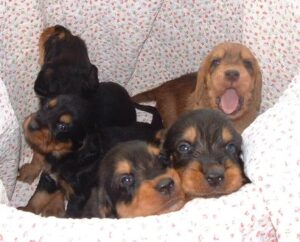
Breeding is a huge commitment. As Otterhound breeders, we are responsible for all puppies produced for their lifetime.
Otterhound’s many color combinations: Black and Tan, Wheaten, Tri-Color White or Off-White with patches of Liver, Tan and Black, Liver and Tan.
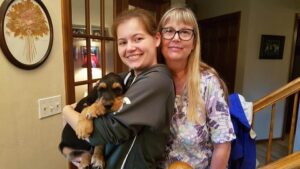
Interview with Hound Group Breeders – Nancy & Karmen Lange – OHeavens Otterhounds – OHeavens is our kennel name. This came from my reaction
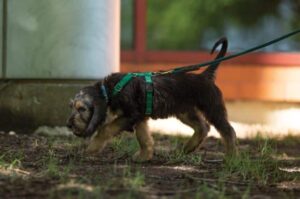
Sometimes they are exhausting, but they do make good workers. So, what do I want when I pick an Otterhound puppy?
Purebred Otterhounds are an old breed of Scenthounds with wiry outer coats that are waterproof, and softer undercoats to keep them warm as

Dan Sayers is the Editor-in-Chief of SHOWSIGHT digital and print publications. He received a B.S. from Drexel University where he studied interior architectural design. His professional career has allowed him to develop his planning, problem-solving, and project management skills, which were employed in the office, educational, and financial sectors. While working as a project manager, he earned a Graphic Design Certificate from the University of the Arts and began creating ads for many of America’s top-winning show dogs. Through this work, Dan became Editor-in-Chief of the nation’s first online-only dog show publication. His current role expands on this experience and broadly extends to cover the sport of dogs in Companion and Performance events as well as all aspects of Conformation.
Dan is a long-time member of the Irish Water Spaniel Club of America and is the organization’s current AKC Delegate and Archivist/Historian, as well as a club-approved Breed Mentor. From 2000-2010, he was the club’s AKC Gazette Columnist. He breeds Irish Water Spaniels under the Quiet Storm prefix and has judged the IWSCA National Specialty Sweepstakes twice. Dan is a member of the Morris and Essex Kennel Club as well as the Dog Writers Association of America, which recognized his illustrations in the award-winning canine compendium, the Encyclopedia of K-9 Terminology.

"*" indicates required fields
Showsight Magazine–the world’s most influential purebred dog publication since 1992. Each issue reaches a global audience dedicated to preserving the history and health of purpose bred dogs. Filled with award-winning editorial focused on news and insights from the dog show community, top breeders, handlers, AKC Judges, and more!